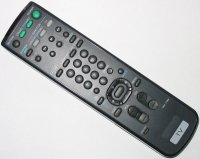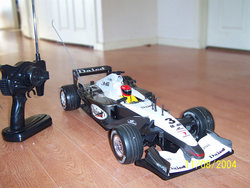Remote control

A remote control is a electronic device used for the remote operation of a machine.
The term is most commonly used to refer to a remote control for televisions or other consumer electronics such as stereo systems and DVD players, and to turn-on and off a mains plug. Remote controls for these devices are usually small handheld objects with an array of buttons for adjusting various settings such as television channel, track number, and volume. In fact, for the majority of modern devices with this kind of control, the remote contains all the function controls while the controlled device itself only has a handful of essential primary controls. Most of these remotes communicate to their respective devices via infrared signals and a few via radio signals. They are usually powered by small AA or AAA size batteries.
History
One of the earliest examples of remote control was developed in 1898 by Nikola Tesla, and described in his patent, U.S. Patent 613809, named Method of and Apparatus for Controlling Mechanism of Moving Vehicle or Vehicles. The first remote controlled model airplane flew 1936. The use of remote control technology for military purposes was worked intensively during the Second World War, one result of this was the German Wasserfall missile. The first remote intended to control a television was developed by Zenith Radio Corporation in the early 1950s. The remote — unofficially called “Lazy Bones” — used a wire to connect to the television set. To improve the cumbersome setup, a wireless remote control was created in 1955. The remote called “Flashmatic” worked by shining a beam of light onto a photoelectric cell. Unfortunately, the cells did not distinguish between light from the remote and light from other sources. The Flashmatic also required that the remote control be pointed accurately at the receiver.
In 1956 Robert Adler developed “Zenith Space Command”, the first modern wireless remote. It was mechanical and used ultrasound to change the channel and volume. When the user pushed a button on the remote control it clicked and struck a bar, hence the term “clicker”. Each bar emitted a different frequency and circuits in the television detected this sound. The invention of the transistor made possible cheaper electronic remotes that contained a piezoelectric crystal that was fed by an oscillating electric current at a frequency near or above the upper limit of human hearing, though still audible to dogs. The receiver contained a microphone attached to a circuit that was tuned to the same frequency. Some problems with this method were that the receiver could be triggered accidentally by naturally occurring noises, and some people, especially young women, could hear the piercing ultrasonic signals. There was even a noted incident in which a toy xylophone changed the channels on these types of TVs since some of the tones from the xylophone matched the remote’s ultrasonic frequency.
In the 1990s, when semiconductors for emitting and receiving infrared radiation were developed, remote controls gradually switched to that technology which, as of 2005, is still widely used. Remotes using radio technologies, such as Bose Audio Systems and those based on Bluetooth also exist.
By the early 2000s, the number of consumer electronic devices in most homes greatly increased. According to the Consumer Electronics Association, an average American home has four remotes. To operate a home theater as many as five or six remotes may be required, including one for cable or satellite receiver, VCR or digital video recorder, DVD player, TV and audio amplifier. Several of these remotes may need to be used sequentially, but, as there are no accepted interface guidelines, the process is increasingly cumbersome. Many specialists, including Jakob Nielsen [1], a renowned usability specialist and Robert Adler, the inventor of the modern remote, note how confusing, unwieldy and frustrating the multiplying remotes have become. To that end, designers of the TiVo remote control replaced the standard columns of buttons on a black rectangle with a distinctive peanut shaped design that has been well received by its users. This design, which has spawned several imitations, is likely to change the way consumer electronics designers approach the remote.
Types of remote controls
Alternatively, universal remote controls combine multiple remotes into one, usually with some sort of switch or button indicating which device the remote is currently controlling. Universal remotes run from inexpensive basic models to a US$700 Linux-powered model from Sony . The first Universal Remote Control was developed by William Russell McIntyre in the mid 1980s, while employed at North American Philips Consumer Electronics Corporation (Magnavox/Sylvania/Philco). McIntyre’s software design was awarded patents, since it was the first remote which could be pointed at an electronic device and learn its operational controls.

Remote or radio control exist for many other devices as well: model airplanes, helicopters and other radio controlled models are popular children’s toys; many robots are remotely controlled, especially those which are designed for doing perilous tasks; and some state of the art military fighter jets are operated by remote control.
Remote controlled firearms are sometimes used to hunt birds and other animals. In 2005, legislation was introduced in Virginia to ban this practice. HB 2273 provided:
- No person shall operate, provide, sell, or use or offer to operate, provide, sell, or use any device or service that allows a person, not physically present, to remotely control a firearm, weapon, or device to hunt any live animal or bird.
